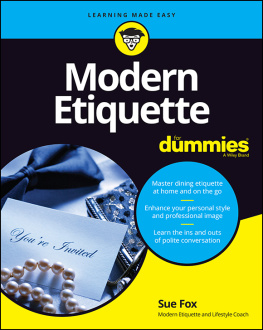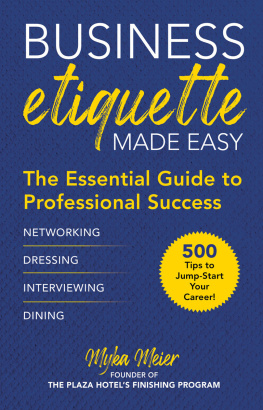Thank you for downloading this AMACOM eBook.
Sign up for our newsletter, AMACOM BookAlert, and receive special offers, access to free samples, and info on the latest new releases from AMACOM, the book publishing division of American Management Association.
To sign up, visit our website: www.amacombooks.org

THE
Etiquette
EDGE
SECOND EDITION
THE
Etiquette
EDGE
SECOND EDITION
MODERN MANNERS FOR
BUSINESS SUCCESS
BEVERLY Y. LANGFORD

Contents
INTRODUCTION
The Case for Courtesy
Todays workplace is a more complex environment than it was just a couple of decades ago. Flatter organizations, decreased power distance, and increased diversity have benefited companies immensely, but with those changes have come more confusion about accepted rules of conduct and interpersonal relationships. Added to that turmoil the inescapable reach of social media and new technology that allows near-constant opportunities for creating friction with others and creating a world where we are connecting but not really connected.
Customs vary, and language and social differences can make effective interaction in the workplace, already challenging, even more daunting. The old rules dont seem to work anymore; we need new practical guidelines to avoid confusion or chaotic behavior.
Unfortunately, since the late 1900s, perhaps even beginning in the 1960s, many people have considered courtesy old-fashioned and good manners elitist. At the same time, many of us are increasingly frustrated with rudeness or social ineptness and lack of professionalism among employees, customers, coworkers, and strangers. Yet most of us will readily admit that our parents concepts of good manners dont always work in the twenty-first century.
THE VALUE OF COURTESY TO YOUR CAREER
Many factors contribute to a persons professional success. Knowledge, skill, work ethic, integrity, ambitionall of these factors are essential to achieving our goals. However, we make a serious mistake if we ignore the importance of effective and appropriate communication and behavior, social savvy, and commonsense etiquette. Failing to recognize how one can seize a competitive advantage by leveraging good manners and courtesy in the workplace can undermine our good efforts on the job.
When asked the secret of his success, the vice president of a major technology company once answered, Its quite simple, really. I learned to anticipate all the possibilities so that I could take action instead of merely responding. And, I remembered the things my mother taught me. The point he wanted to make was that these early lessons had taught him the importance of treating others well, whether we call it etiquette, good manners, courtesy, civility, or social savvy.
Without question, if you aspire to a management or leadership position, treating others with courtesy and respect is critical to building trust and credibility. And being a credible, trustworthy leader is a key factor in inspiring others to follow you. However, courtesy should not be viewed as a management tool implemented simply to manipulate others. True courtesy has as its source a genuine ability to value other people and to see their worth, regardless of their status.
Treating people courteously either out of guilt or because we feel that a particular person is important or can help our career is inauthentic, and other people will soon recognize the insincerity. On the other hand, you can learn to be genuinely courteous, and usually the effect on others and their behavior is the best reinforcement for adopting a habit of courtesy. In most cases, when we extend genuine courtesy to others, they respond positively to us. And having people respond to us positively is a great confidence booster. In turn, as we become more secure about ourselves, we become increasingly comfortable treating others well, and soon courtesy becomes an integral element of our character.
WHO CAN USE THIS BOOK?
This book provides some commonsense guidelines for handling some common workplace situations in which knowing the right behavior can make the difference in how others see us and respond to us.
Whether you are an established manager, in a new job, or entering or reentering the workforce, a quick review of how to behave in a variety of workplace situations will help you establish yourself as a socially mature, valuable colleague whom people trust, admire, and want to be around.
Interpersonal communication is always unpredictable because we are each as unique as our fingerprints. Therefore, you need to judge the ideas presented here against the requirements of your own personality and those of your audience. Choose what works for you, and put your own spin on those suggestions that work for you in order to increase the chances of making your relationships with others solid and mutually beneficial. As you read the chapters, consider how you can apply some of these principles to your current or future work situations.
GETTING THE MOST FROM THIS BOOK
Think about the interpersonal skills you want to develop. Are you uncomfortable in social situations with strangers? Do you struggle with building an effective network of contacts you can call on when you need specific resources? Do you want to make a better first impression? Do you want to increase your authority and influence among coworkers? Do working lunches give you heartburn? Are you unsure about how to interpret nonverbal signals?
Pick out the topics or chapters that seem to fit your particular needs and focus on those sections. Youll notice that each chapter ends with a bulleted summary entitled The Bottom Line, which highlights the major messages of that section.
Although our complex world doesnt provide simple answers, we can always find ways to make interacting with our fellow human beings more rewarding and interesting. Were all on this often exciting, frustrating, perplexing, exhilaratingand rarely ever boringjourney.
If we work together, we can all enjoy the trip.
TEST YOUR CQ (COURTESY QUOTIENT)
To get started on developing courteous behaviors, take this quiz to check your courtesy quotient (CQ). The answer key at the end will give you an indication of your understanding of key issues of courtesy and interpersonal savvy and your proficiency in handling them. Some situations may depend more on good judgment than a widely-accepted rule. In case of more than one right answer, choose the one with which you would feel most comfortable. You may wish to retake the quiz after reading the book to see if you have changed your mind about any of your answers.
You are in the office on the telephone and another call comes in. You should:
a) Ask the person if you can put him or her on hold.
b) Let voicemail take it.
c) Tell the person you are talking to that you must put him or her on hold a moment.
You call a colleague and put your phone on speakerphone. Another coworker is in the room. You should:
a) Mention neither the speakerphone nor the other person in the room.
b) Tell the person on the phone that you wish to use the speakerphone. Mention the other person in the room, and ask the person on the phone if this is okay.
c) Tell the person on the phone that you are using the speakerphone, but dont mention the other person in the room.
Next page








